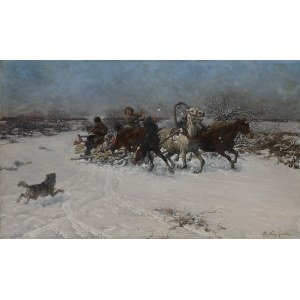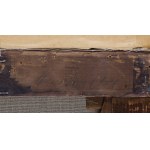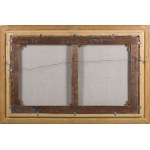59.8 x 99.0 cm - oil, duplicated canvas signed p.d.: Alfred Wierusz-Kowalski
On the reverse a sticker (print): von Possenhofen; below, illegible inscription in crayon; next to no. (in crayon): K N o 15.
The sticker on the reverse of the painting may suggest that the painting was in the collection of the Possenhofen palace. This palace was purchased by Prince Maximilian of Bavaria in 1843 as a summer residence. It sits southwest of Munich, on the banks of the picturesque Starnberg Lake. It was here that Princess Elisabeth of Bavaria, later Empress Sisi, spent her happiest childhood years. Until the 1920s, the castle remained in the possession of the Dukes of Bavaria.
Alfred Wierusz-Kowalski, as a contemporary reviewer wrote, spun the yarn of his compositional ideas, in which landscape, people and horses play an equivalent role, from rural life, from native Polish realities. These works were highly valued and sought after on the art market, both because of their "exotic" subject matter for Western audiences and the painter's mastery. What is striking about these paintings is the attention to reality, the excellent characterization of the figures of people and the perfectly captured horses in motion, as well as the virtuoso reproduction of light and snow, shimmering in shades of pink, bluish green and blue.
Paintings depicting wolves attacking travelers riding in sleighs were among Wierusz-Kowalski's most popular and sought-after compositions. They are the ones that primarily perpetuated his fame. The artist took this theme from his childhood memories - as an eight-year-old boy he himself experienced a similar adventure and, together with his family, found himself in mortal danger. He painted many pictures with wolves, and studied the wolf himself like few others. These compositions were aptly characterized by Eligiusz Niewiadomski, writing, among other things: the mad rush of the sleigh, the buckled horses, crazed with fear, tear every spirit in their chests through the bushes. In the sleigh, someone with an eye dementedly clenches the shortbow in his hand, there further on some beast is pounding, dyeing the snow with sweat. As a whole - not a trivial juxtaposition of people, horses and wolves, but an essential, down to earth sensed drama where death and life are at stake, rendered with astonishing freedom, truth and variety of variants of one and the same idea. The paintings were wildly successful, and were bought by rich Germans and especially Americans and English. (E. Niewiadomski, Malarstwo polskie XIX i XX wieku, Warsaw 1926, p. 182).
The presented Niebezpieczna jazda is one of the earlier - and exceptional class - paintings of this kind. In addition to its dramatic anecdotal layer, it also draws attention with its brilliantly painted, typically Polish landscape with snow-covered fields.
Dangerous Driving is one of Wierusz-Kowalski's striking, highly decorative works from his best period. Both the way it is painted and the way it is signed point to circa 1880. The wolf attack depicted in the vast winter landscape is painted with confidence, with great care in rendering the smallest details. In addition to the attention to reality, the excellent characterization of the figures is striking - the viewer empathizes with both the terror the artist has painted on the coachman's face and the calmness with which the man on the wagon takes aim at the wolf. Attention is also drawn to the brilliantly studied dog, which is ready to defend its traveling companions at all costs. The painter has brilliantly captured the movement of the speeding horses and the clods of snow flying from under the hooves high above the horses' heads. The depiction of the horses at full gallop, with their manes fanned out and hooves torn from the ground, gives the whole scene a dynamic feel.
Alfred Wierusz-Kowalski (Suwałki 1849 - Munich 1915) - one of the most prominent Polish painters of the so-called Munich School was, along with Jozef Brandt and Władysław Czachórski, also the most popular of the Polish artists settled and permanently active in Munich. He settled there in 1873, having already studied in Warsaw and Dresden. He studied for a year more at Munich's Academy of Fine Arts under Alexander Wagner, before moving to Brandt's private studio. He gained critical and public recognition early on; his paintings, decorated with medals at exhibitions, were coveted by collectors and German dealers. In 1890 he became an honorary professor at the Munich Academy. He painted genre and genre-historical scenes with motifs of horsemen, knights, hunters, horses, wolves and snow. After a trip to Africa in 1903, he also took up oriental themes. Relatively few of the artist's works were found in Polish museum collections - his paintings sold mainly on the German market in greater numbers went to private collections, mainly in Germany and the United States. Present often appear also on the Polish art market, always arousing the interest of collectors.
Recently viewed
Please log in to see lots list
Favourites
Please log in to see lots list














